- Главная
- Разное
- Бизнес и предпринимательство
- Образование
- Развлечения
- Государство
- Спорт
- Графика
- Культурология
- Еда и кулинария
- Лингвистика
- Религиоведение
- Черчение
- Физкультура
- ИЗО
- Психология
- Социология
- Английский язык
- Астрономия
- Алгебра
- Биология
- География
- Геометрия
- Детские презентации
- Информатика
- История
- Литература
- Маркетинг
- Математика
- Медицина
- Менеджмент
- Музыка
- МХК
- Немецкий язык
- ОБЖ
- Обществознание
- Окружающий мир
- Педагогика
- Русский язык
- Технология
- Физика
- Философия
- Химия
- Шаблоны, картинки для презентаций
- Экология
- Экономика
- Юриспруденция
Что такое findslide.org?
FindSlide.org - это сайт презентаций, докладов, шаблонов в формате PowerPoint.
Обратная связь
Email: Нажмите что бы посмотреть
Презентация на тему Flora of australia
Содержание
- 2. General characteristicsThe flora of Australia comprises a vast assemblage of plant
- 3. Natural history of AustraliaAustralia was part of
- 4. Vascular plantsAustralia has over 30,000 described
- 5. Non-vascular plants The algae are a large
- 6. Use by humans The first Australian plants
- 7. Since European colonisationEconomic exploitation of the flora
- 8. Скачать презентацию
- 9. Похожие презентации
General characteristicsThe flora of Australia comprises a vast assemblage of plant species estimated to over 20,000 vascular and 14,000 non-vascular plants, 250,000 species of fungi and over 3,000 lichens. The flora has strong affinities with the flora of Gondwana, and below the family level has a highly endemic angiosperm flora whose
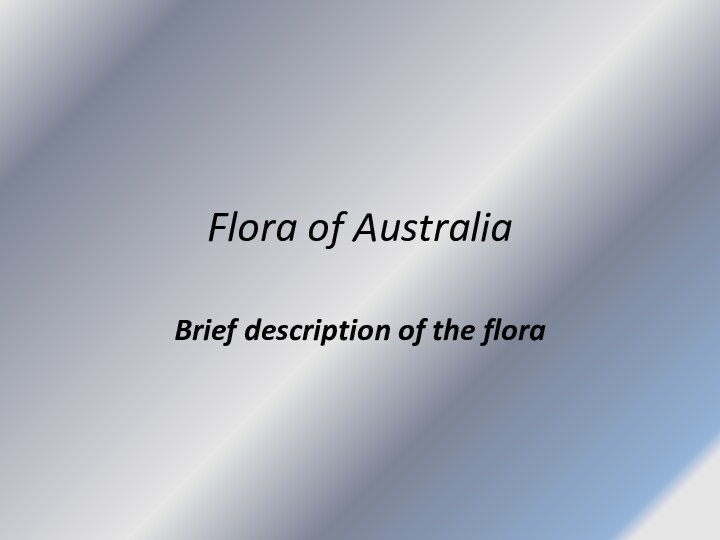
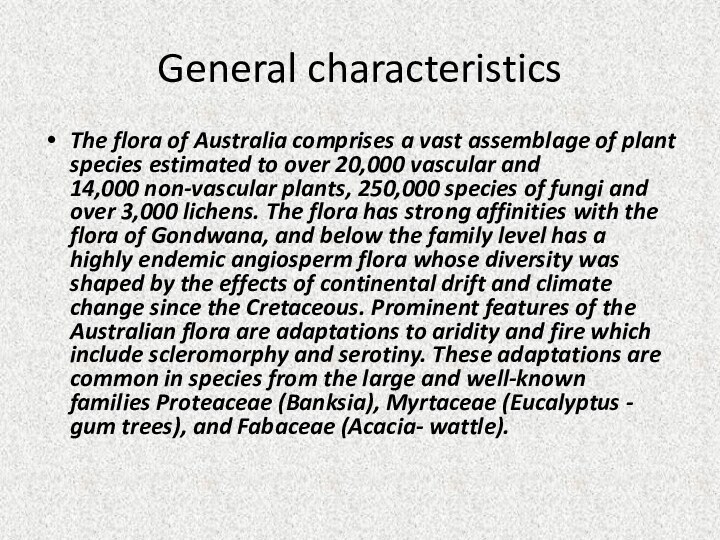

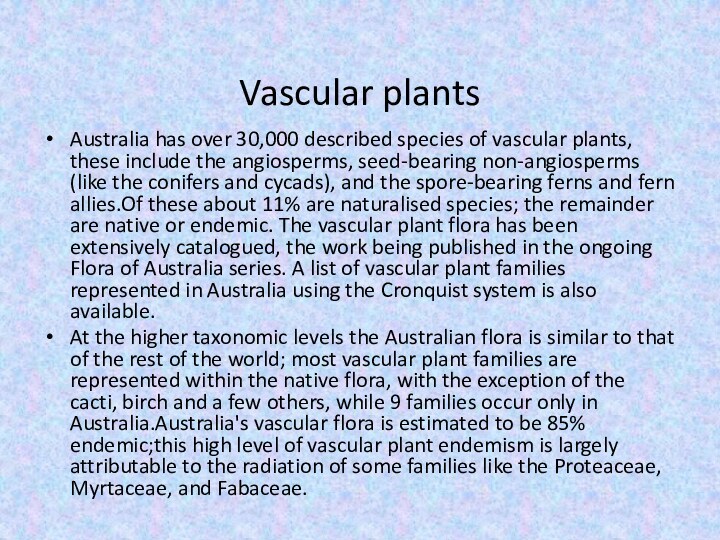
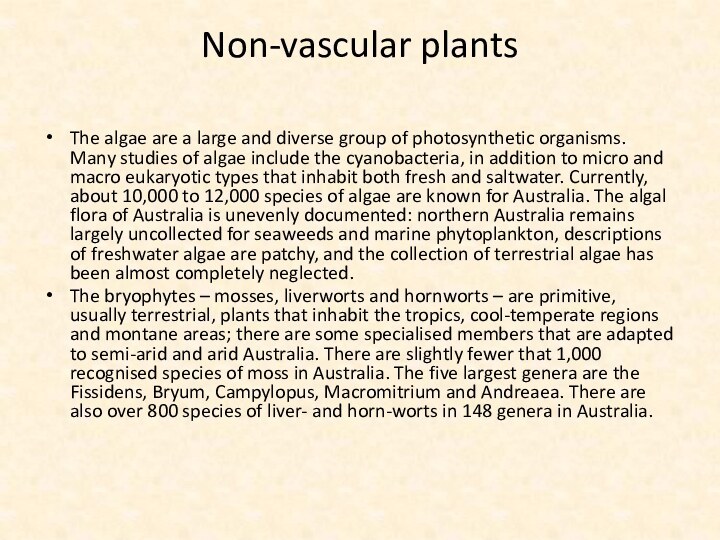


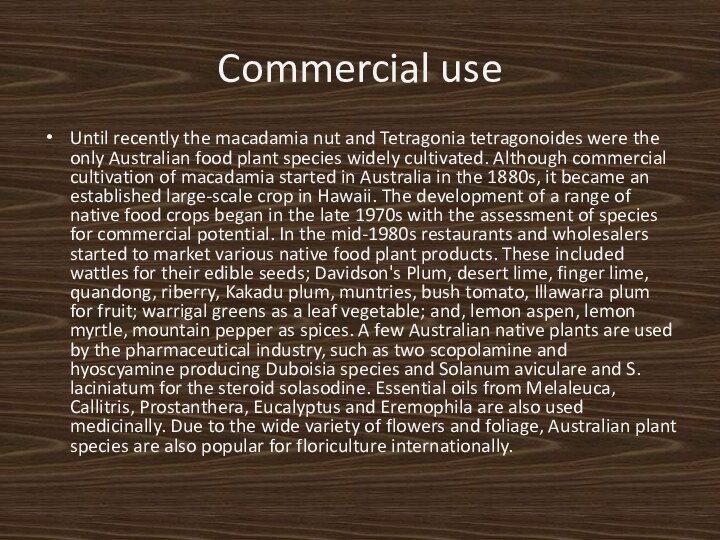
Слайд 3
Natural history of Australia
Australia was part of the
southern supercontinent Gondwana, which also included South America, Africa,
India and Antarctica. Most of the modern Australian flora had their origin in Gondwana during the Cretaceous when Australia was covered in subtropical rainforest. Australian ferns and gymnosperm bear strong resemblance to their Gondwanan ancestors,and prominent members of the early Gondwanan angiosperm flora such as the Nothofagus, Myrtaceae and Proteaceae were also present in Australia.Scrubland with Xanthorrhoea following bushfire.
Gondwana began to break up 140 million years ago (MYA); 50 MYA during the Eocene Australia separated from Antarctica, and was relatively isolated until the collision of the Indo-Australian Plate with Asia in the Miocene era 5.3 MYA. As Australia drifted, local and global climate change had a significant and lasting effect: a circumpolar oceanic current developed, atmospheric circulation increased as Australia moved away from Antarctica, precipitation fell, there was a slow warming of the continent and arid conditions started to develop. These conditions of geographic isolation and aridity led to the development of a more complex flora. From 25-10 MYA pollen records suggest the rapid radiation of species like Eucalyptus, Casuarina, Allocasuarina, Banksia and the pea-flowered legumes, and the development of open forest; grasslands started to develop from the Eocene. Collision with the Eurasian Plate also led to additional South-east Asian and cosmopolitan elements entering the flora like the Lepidium and Chenopodioideae.
The development of aridity and the old and nutrient poor soils of the continent led to some unique adaptations in the Australian flora and evolutionary radiation of genera – like Acacia and Eucalyptus – that adapted to those conditions. Hard leaves with a thick outer layer, a condition known as scleromorphy, and C4 and CAM carbon fixation which reduce water loss during photosynthesis are two common adaptations in Australian arid-adapted dicot and monocot species respectively. Rising aridity also increased the frequency of fires in Australia. Fire is thought to have played a role in the development and distribution of fire-adapted species from the Late Pleistocene. An increase in charcoal in sediment around 38,000 years ago coincides with dates for the inhabitation of Australia by the Indigenous Australians and suggests that man-made fires, from practices like fire-stick farming, have played an important role in the establishment and maintenance of sclerophyll forest, especially on the east coast of Australia. Adaptations to fire include lignotubers and epicormic buds in Eucalyptus and Banksia species that allow fast regeneration following fire. Some genera also exhibit serotiny, the release of seed only in response to heat and/or smoke. Xanthorrhoea grass trees and some species of orchids only flower after fire.
Слайд 4
Vascular plants
Australia has over 30,000 described species of
vascular plants, these include the angiosperms, seed-bearing non-angiosperms (like
the conifers and cycads), and the spore-bearing ferns and fern allies.Of these about 11% are naturalised species; the remainder are native or endemic. The vascular plant flora has been extensively catalogued, the work being published in the ongoing Flora of Australia series. A list of vascular plant families represented in Australia using the Cronquist system is also available.At the higher taxonomic levels the Australian flora is similar to that of the rest of the world; most vascular plant families are represented within the native flora, with the exception of the cacti, birch and a few others, while 9 families occur only in Australia.Australia's vascular flora is estimated to be 85% endemic;this high level of vascular plant endemism is largely attributable to the radiation of some families like the Proteaceae, Myrtaceae, and Fabaceae.
Слайд 5
Non-vascular plants
The algae are a large and diverse
group of photosynthetic organisms. Many studies of algae include
the cyanobacteria, in addition to micro and macro eukaryotic types that inhabit both fresh and saltwater. Currently, about 10,000 to 12,000 species of algae are known for Australia. The algal flora of Australia is unevenly documented: northern Australia remains largely uncollected for seaweeds and marine phytoplankton, descriptions of freshwater algae are patchy, and the collection of terrestrial algae has been almost completely neglected.The bryophytes – mosses, liverworts and hornworts – are primitive, usually terrestrial, plants that inhabit the tropics, cool-temperate regions and montane areas; there are some specialised members that are adapted to semi-arid and arid Australia. There are slightly fewer that 1,000 recognised species of moss in Australia. The five largest genera are the Fissidens, Bryum, Campylopus, Macromitrium and Andreaea. There are also over 800 species of liver- and horn-worts in 148 genera in Australia.
Слайд 6
Use by humans
The first Australian plants recognised and
classified in Linnaean taxonomy were a species of Acacia
and Synaphea in 1768 as Adiantum truncatum and Polypodium spinulosum respectively by Dutch philologist Pieter Burman the Younger, who stated they were from Java. Later, both were found to be from Western Australia, likely to have been collected near the Swan River, possibly on a 1697 visit there of fellow Dutchman Willem de Vlamingh. This was followed by Cook's expedition making landfall at what is now Botany Bay in April 1770, and the early work of Banks, Solander and Parkinson . Botanical exploration was enabled by the founding of the permanent colony at Port Jackson in 1788, and the subsequent expeditions along Australia's coastline.The Australian flora was utilised by the Indigenous inhabitants of Australia. Indigenous Australian's used hundreds of species for food, medicine, shelter, tools and weapons. For example, the starchy roots of Clematis microphylla were used in western Victoria to make a dough that was baked, and the leaves of the plant were used as a poultice applied to skin irritations and blisters.





























